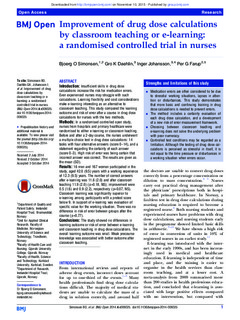Improvement of drug dose calculations by classroom teaching or e-learning: a randomised controlled trial in nurses
Journal article, Peer reviewed
Permanent lenke
http://hdl.handle.net/11250/2375558Utgivelsesdato
2014Metadata
Vis full innførselSamlinger
Sammendrag
Introduction: Insufficient skills in drug dose calculations increase the risk for medication errors. Even experienced nurses may struggle with such calculations. Learning flexibility and cost considerations make e-learning interesting as an alternative to classroom teaching. This study compared the learning outcome and risk of error after a course in drug dose calculations for nurses with the two methods.
Methods: In a randomised controlled open study, nurses from hospitals and primary healthcare were randomised to either e-learning or classroom teaching. Before and after a 2-day course, the nurses underwent a multiple choice test in drug dose calculations: 14 tasks with four alternative answers (score 0–14), and a statement regarding the certainty of each answer (score 0–3). High risk of error was being certain that incorrect answer was correct. The results are given as the mean (SD).
Results: 16 men and 167 women participated in the study, aged 42.0 (9.5) years with a working experience of 12.3 (9.5) years. The number of correct answers after e-learning was 11.6 (2.0) and after classroom teaching 11.9 (2.0) (p=0.18, NS); improvement were 0.5 (1.6) and 0.9 (2.2), respectively (p=0.07, NS). Classroom learning was significantly superior to e-learning among participants with a pretest score below 9. In support of e-learning was evaluation of specific value for the working situation. There was no difference in risk of error between groups after the course (p=0.77).
Conclusions: The study showed no differences in learning outcome or risk of error between e-learning and classroom teaching in drug dose calculations. The overall learning outcome was small. Weak precourse knowledge was associated with better outcome after classroom teaching.
Beskrivelse
-
